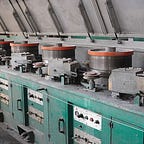How Does a Wire Drawing Machine Work?
A wire drawing machine is a versatile and essential tool used in the manufacturing industry for producing precision metal parts. It works by stretching or flattening a metal wire into a desired cross-sectional shape using mechanical force. In this article, we will explore the basic principles of how a wire drawing machine works and the different types of wire drawing processes it can perform.
The basic principle behind a wire drawing machine is to apply mechanical force to a metal wire to stretch or flatten it into a specific cross-sectional shape. The machine consists of a series of rollers, guides, and tensioners that work together to achieve the desired result. The following are the steps involved in the working of a wire drawing machine:
Wire preparation: The first step in using a wire drawing machine is to prepare the wire by removing any burrs, kinks, or imperfections. This is done using a wire brush or other suitable tools to ensure that the wire is straight and free of defects before feeding it into the machine.
Wire feeding: The wire is then fed into the machine through a chute or hopper. The feeder mechanism varies depending on the type of machine being used, but most involve the use of a screw or gear system to control the speed and direction of the wire as it moves through the machine.
Roller assembly: Once the wire has been fed into the machine, it passes through a set of rollers that guide it along its path. The rollers come in different shapes and sizes, depending on the desired cross-sectional shape of the finished part. For example, if you want to produce a flat sheet of metal, you would use rollers with larger diameters to provide more surface area and reduce thickness. If you want to produce a round or oval part, you would use rollers with smaller diameters to create the desired shape.
Tensioning: As the wire passes through the rollers, it is pulled tighter and stretched longer by the tensioners mounted on the machine. This helps to maintain consistent tension throughout the length of the wire, which is critical for achieving accurate and consistent results.
Cutting: Once the desired cross-sectional shape has been achieved, the wire is cut using specialized cutting tools such as scissors or knives. These tools are mounted on rotating axes that allow them to move along the length of the wire, making precise cuts as needed.
Cooling and Finishing: After cutting, the finished part is typically cooled to remove any residual stresses or distortions caused by heat during cutting. This is followed by any necessary finishing operations such as grinding, polishing, or painting to prepare the part for further processing or assembly.
There are several different types of wire drawing processes that can be performed using a wire drawing machine, depending on the desired outcome. Some of the most common include:
Cold rolling: This process involves stretching a metal wire while it is still hot from the rolling mill. The resulting cross-sectional shape is relatively soft and can be easily shaped by hand or other shaping tools. Cold rolling is commonly used for producing thin sheet metal products such as aluminum foil, copper-clad plates, and electrical wiring.
Annealing: Annealing is a process that involves heating a metal wire to a high temperature and then quickly cooling it down again. This process causes the metal to soften and become more malleable, which makes it easier to shape and form. Annealing is commonly used for producing springs, rods, and other components that require high strength and flexibility.
Hardening: Hardening is a process that involves heating a metal wire to a high temperature in order to increase its strength and toughness. This process is commonly used for producing components that require high wear resistance and durability, such as bearing races and gear teeth.
In conclusion, a wire drawing machine is an essential tool for manufacturers who need to produce precise metal parts with consistent quality and accuracy. By understanding how a wire drawing machine works and the different types of wire drawing processes it can perform, manufacturers can ensure that they are using the right tool for their specific needs and achieving optimal results in their production processes.
